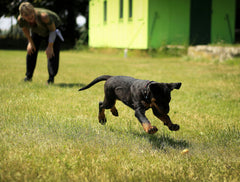
Puppy paws are irresistibly cute and hard to resist cooing over. As the owner of a puppy or even a dog, it's important to know about their paw pads and certain care needed that should be addressed. Below, you will find four things that you may or may not already know about dog feet. About their anatomy, your dog’s relationship with them, and various care needs that you probably should be keeping up with.
Your dog’s paws are incredibly important to them, and there is only so much they can do themselves to take care of them. We as humans have learned a lot about dogs and their paws over time so that we can better care for them and give our pets a long and happy life with us.
All Paws are Different

Among the hundreds of different breeds of dogs there are in the world, the different breeds each have unique qualities to them. Such as certain Terriers or Akitas have paws that are called “cat feet”. This means their third toe is generally shorter than the first two. Making it more compact looking, much like a cat paw.
Or if you look at larger dog’s breeds such as the St. Bernard, you will notice that their paws are larger and much wider. This isn’t just to accommodate for their larger stature. This breed, like many other larger breeds, live in an area where winter weather can become harsh.
Their paws have adapted to this climate and essentially work as snowshoes for these large fogs so that they can run through the snow for long distances with no problem. There are also some dogs that go by the title of “water dog”. This is because their paws appear to be webbed. Although swimming wasn’t the primary use of these paws, they certainly do come in handy.
Dog Paws Can Handle Nature

Dog paws are naturally waterproof, but that doesn’t account for all terrain and temperature. The paw pad of a dog's feet can handle almost anything that nature had to throw at them. The anatomy of a dog’s paw pads is pretty simple, but perfectly created for a dog's lifestyle. They are made of thick fatty tissue that can withstand freezing cold temperatures as well as rough and rocky terrains.
Heat, however, is not something that dog paws can withstand as easily as they can cold weather. Caution needs to be taken when considering bringing your dog out for a walk on a hot day. Their paw pads are at high risk for becoming burnt or injured if they are exposed to direct heat for prolonged periods of time.
A good rule of thumb is that if you cannot leave your hand or bare foot on hot pavement for a couple minutes your dog's paws shouldn’t be out on it for very long either.
This makes it important for you, as a dog owner, to consider purchasing dog paw moisturizer like our Organic Dog Paw Balm for your dog after facing harsh cold or warm environments.
Dogs Sweat Glands are in their Feet

It’s common knowledge to many dog owners that dogs easily overheat due to their lack of diffuse sweat glands. Dogs only sweat through their noses and the pads of their paws, making it hard for them to cool down in hot environments. Of course, dogs can also get rid of excess heat through panting.
Because dogs sweat through the pads of their paws, they sometimes develop a particular foot odor. This odor is often referred to as “Frito feet” or “popcorn feet”. This is because this scent is often recognized as being like the smell of corn chips or popcorn.
This happens because of the combination of the bacteria that is naturally present on your dog’s feet and the environmental microorganisms that they come in contact with.
If you're looking for ways to keep your dog cool this summer, check out these tips!
Some Dog Paws are Made for Swimming

It may come as a surprise that some breeds of dogs have webbed paws, made for swimming. Breeds such as Portuguese water dogs or Newfoundland’s are born with paws that are well equipped for swimming and taking on water. However, the reason these webbed feet came about originally was for the purpose of digging and hunting.
Conclusion
Dog paws come in all sorts of different shapes, sizes, and colors. Making them all unique and in need of special care. Your dog’s paws are very important to them and need to be cared for by you just as much as the rest of them.
Yes, dogs are animals and they’re tough and durable to some degree. But just because they are animals doesn’t mean their paws don’t deserve some consideration on a hot day or some doggy moisturizer on a cold day.




